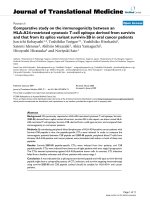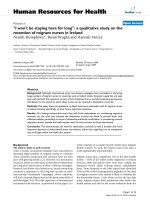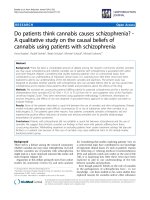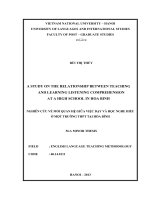Comparative study on the surface treatment for marine structure rehabilitation with glass Fiber-Reinforced high strength Self-Compacting mortar
Bạn đang xem bản rút gọn của tài liệu. Xem và tải ngay bản đầy đủ của tài liệu tại đây (465.27 KB, 7 trang )
Comparative study on the surface treatment for marine structure rehabilitation
with glass Fiber-Reinforced high strength Self-Compacting mortar
Nguyen Viet Duc1
Abstract: Rehabilitation method plays an important role in maintenance process of the structure in
general and the marine structure in particular. This paper aims to present a comparative study on the
surface treatment for marine structure rehabilitation with glass fiber-reinforced high strength selfcompacting mortar or SCM. Three types of rehabilitation methods in terms of surface treatment are ascast surface, surface prepared with steel brush and surface with hole-connector. The experimental results
showed that flexural strength of rehabilitated beam with as-cast surface, surface prepared with steel
brush, and surface with hole-connector has improved 22%, 31% and 4% respectively higher than that of
non-rehabilitated one. The precracked rehabilitated beams had load-carry capacity, for the case of ascast surface, surface prepared with steel brush, and surface with hole-connector, their flexural strength
were 41%, 37% and 31% respectively that of the corresponding non-precracked beams. Visual
observation of the non-rehabilitated and rehabilitated beam cross-section after the third-point bending
test revealed that their failure mode was similar. Besides, regarding the rehabilitated beams, there is no
crack between conventional concrete and SCM.
Keywords: Rehabilitation, surface treatment, marine structure, high strength self-compacting mortar.
1. Introduction *
Nowadays, with the great progress of science
and engineering in general, material science and
technology are also gaining important
achievements. These achievements are making
important developments to create many types of
materials with superiority applied in all areas of
life. One of these important materials that must
be mentioned is concrete (Aitcin, 1998). In the
construction engineering industry, concrete
plays an important role and is used with large
amount in construction works, especially marine
structures (Bentur & Mindess, 1990). Since the
1990s, Mehta has stated that “The 21st century
will be known as the century of concrete in
marine environments” (Mehta, 1990). This
judgment has attracted the attention of many
1
Division of Construction Materials, Faculty of Civil
Engineering, Thuyloi University
Received 24th Mar. 2022
Accepted 15th Apr. 2022
Available online 31st Dec. 2022
2
research experts in the field of materials as well
as countries bordering the sea including
Vietnam (Cao, 1999).
Due to working in the marine environment,
which has strong corrosive agents and is
affected by a combination of many factors,
marine constructions are often much lower in
durability and actual life than those in the river.
The lifetime and quality of these buildings
depend on the durability of the concrete
structures or the quality of the concrete used.
With the application of scientific and technical
advances into the concrete fabrication
technology, it allows us to produce high quality,
reinforced concrete and fiber reinforced
concrete structures with long lifetime (Hoang,
2011; Nguyen, 2016).
When the concrete structure exposed to the
marine environment, steel fiber inclusion might
be suffered from corrosion. Thus, glass fiber
seems to be an effective option (Ngo, 2020).
With the aim to attempt to rehabilitate marine
Journal of Water Resources & Environmental Engineering - No. 82 (12/2022)
structure, this paper intends to present in detail
the rehabilitation work of structural element by
using glass fiber-reinforced high strength selfcompacting
mortar
(SCM).
Several
rehabilitation methods in terms of surface
treatment such as as-cast surface, surface
prepared with steel brush and surface with holeconnector will be presented in details. The
outcome would serve for further investigation
on the application of this SCM not only for the
rehabilitation of marine structure, but also for
producing other innovative structure for coastal
protection in Vietnam.
2. Specimen
preparation
and
experimental program
2.1. Material used
Materials used in this study are following:
Ordinary Portland cement OPC40, silica fume,
natural sand from Lo River- Phu Tho Province,
and manufactured sand and crushed stone from
Kien Khe - Ha Nam Province.
Besides, alkali resistant glass fiber
conforming to ASTM C1666 was used for SCM
mix. Superplasticizer was a high-range water
reducer admixture, which is a third generation
polycarboxylate
superplasticizer
with
a
commercial brand VMAT-PC01. Lastly, water
used for the proportion mix was tap water at
Hanoi area.
Details of the material used in this study in
term of physical and mechanical characteristic
of cement and silica fume, sieve analysis and
characteristic of coarse and fine aggregates, as
well as characteristic of glass fiber,
superplasticizer, and water can be found in the
previous publication (Nguyen, 2020).
2.2. Mix proportion of conventional
concrete and SCM
In this study, two types of concrete mix
proportion were designed. The first one was
conventional concrete of strength class 30
MPa. This type of concrete was used for
preparation of the reference structure or in
practice existing structure that needs to be
rehabilitated. While, the second is SCM mix
of strength class 60 MPa used for
rehabilitating the marine structure. Some
“trial-and-error” were involved to adjust the
dosage of water and superplasticizer content.
Eventually, the mix proportion and properties
of conventional concrete and SCM used in
this study were obtained and they can be
found in details in Refs (Ngo, 2000;
Nguyen, 2020).
2.3. Rehabilitation method
Three rehabilitation methods in terms of
surface treatment including as-cast surface,
surface prepared with steel brush and surface
with hole-connector are involved in this study.
The as-cast surface, as shown in Figure 1,
implies that the surface is left untreated as
original upon casting SCM for rehabilitation
procedure.
Figure 1. As-cast surface
The second method is to make the surface
smoother by using a steel brush, as shown in
Figure 2. The steel brush seems to remove 1-2
mm depth of mortar on the surface of the
structure that needs to be rehabilitated.
a) Grinding with steel brush
Journal of Water Resources & Environmental Engineering - No. 82 (12/2022)
3
b) After surface treatment
Figure 2. Surface prepared with steel brush
On the other hand, the surface with holeconnector, as a name, presents a series of holes,
which are obtained by using a drill, as shown in
Figure 3. The hole has 5 mm diameter and 5
mm depth. The distance from one to another is
50 mm and to the edge is 25 mm. The holes
make the SCM seems to penetrate into the
structure needs to be rehabilitated, which in turn
results in a good connection one to another.
precracked, as shown in Figure 4, to simulate
the case that the structure had been damaged
before, which in turn it needs to be rehabilitated
for the improvement of life service.
Once there are available the beams that need to
be rehabilitated and they are all settled into the
moulds, the rehabilitation procedure starts with
SCM preparation, as shown in Figure 5. SCM is
then poured on the top surface of the beam that
needs to be rehabilitated (400x100x70 mm3) to
make a new one with a dimension of
400x100x100 mm3, as can be observed in Figure
6. Besides, for the comparative study, the
reference beam made of conventional concrete
still has a dimension of 400 mm length, 100 mm
width and 100 mm height.
Figure 4. Precracked beam
a) Making a series of holes by using a drill
When the rehabilitation procedure finished, all
of the beams that have been rehabilitated were kept
in the laboratory for 24 hours, then they were
removed from the molds and cured under the
standard condition (T=20±2oC; W>95%) in the
curing chamber up to the testing date. While the
reference beam was kept in the laboratory up to the
testing date at the same age as the rehabilitated one.
b) After surface treatment
Figure 3. Surface with hole-connector
2.4. Rehabilitation procedure
In this study, the author takes a beam element
as a simple example of rehabilitation for marine
structure. The beam that needs to be
rehabilitated has a dimension of 400 mm length,
100 mm width and 70 mm height. Apart from
the uncracked beams, several beams have been
4
Figure 5. SCM preparation
Journal of Water Resources & Environmental Engineering - No. 82 (12/2022)
2.5. Experimental program
After the rehabilitation procedure 28 days,
the reference and rehabilitated beams were
subjected to bending test to define flexural
strength, as illustrated in Figure 7. The thirdpoint bending test is used with a span length of
300 mm and the distance between load
application points is 100 mm.
rehabilitated and rehabilitated beams of the same
size (100x100x400 mm3) under third-point
bending test. The non-rehabilitated beam consists
of entirely conventional concrete. While, the
rehabilitated beams with three different surface
treatments (as-cast surface, surface prepared with
steel brush, and surface with hole-connector)
contain a 30 mm SCM layer at the bottom apart
from conventional concrete on the top.
Figure 7. Third-point bending test
Table 1. Performance of non-rehabilitated and
rehabilitated beams under third-point bending
Beam
Figure 6. SCM casting for rehabilitation
In fact, in the practical rehabilitation, SCM can
be applied on the top or at the bottom, wherever it
is needed, of the beam in operation. However,
when the beam is on the bending test, there is a
sagging and hogging moment in the beam, the
bottom layer is under tension and the top layer is
under compression. Since SCM works well on
tension much better than conventional concrete
due to the addition of fiber, thus the rehabilitated
beam was placed to bending test so that the SCM
layer was at the bottom to improve the efficient
use of costly SCM.
3. Results and discussion
3.1. Performance of rehabilitated beams
Table 1 provides a detailed result of non-
Non-rehabilitated
Rehabilitated by the
as-cast surface
Rehabilitated by the
surface prepared with
steel brush
Rehabilitated by the
surface with holeconnector
Flexural strength at 28 days
MPa
3.15
2.93
3.06
3.75
3.77
3.63
1.49*
1.53*
3.96
4.05
4.01
1.57*
1.42*
3.23
3.11
3.17
0.93*
1.01*
(*) Precracked beam before rehabilitation
Journal of Water Resources & Environmental Engineering - No. 82 (12/2022)
5
Figure 8 shows an average result of
flexural strength of the non-rehabilitated and
rehabilitated beams under third-point bending
test. It is observed that flexural strength of
rehabilitated beam with as-cast surface,
surface prepared with steel brush, and surface
with hole-connector has improved 22%, 31%
and 4% respectively higher than that of nonrehabilitated one.
Among the rehabilitated beams, it can be
seen that the one of surface prepared with
steel brush has yielded the highest result,
which is 8% and 26% higher than that of ascast surface and surface with hole-connector
respectively.
Regarding the precracked rehabilitated
beams, if there was no rehabilitation process,
the precracked beams would not rather carry
more load due to mainly the brittleness of
concrete material (Neville, 2002). Looking into
Figure 8, these beams sustained more load, for
the case of as-cast surface, surface prepared
with steel brush, and surface with holeconnector, their flexural strength were 41%,
37% and 31% respectively that of the
corresponding
uncracked
beam.
This
remarkable outcome indicates the significant
role of SCM in the rehabilitation. Among the
precracked rehabilitated beams, flexural
strength of the one of as-cast surface and surface
prepared with steel brush was similar and they
were 50% higher than that of the one of surface
with hole-connector.
3.2. Failure mode
Visual observation on the non-rehabilitated
and rehabilitated beam cross-section after the
third-point bending test, as shown in Figure 9,
depicts the next two points. Firstly, the failure
mode of the non-rehabilitated and rehabilitated
beam was similar, as it is seen that the main
crack was developed up to failure in the middle
6
third of the beam, where it receives the
maximum
bending
moment.
Secondly,
regarding the rehabilitated beams, there is no
crack between conventional concrete and SCM,
even though there was a cold-joint, as SCM was
cast onto the conventional concrete when it had
hardened before. In case of precracked beam
before rehabilitation, the rehabilitated beam
failed at the same crack that has been appeared
previously.
Figure 8. Average result of flexural strength
of non-rehabilitated and rehabilitated beams
under third-point bending
It is remarkable to note that in case of the
rehabilitated beams of surface with holeconnector, there was a slight delamination
between conventional concrete and SCM at the
location amid adjacent holes, as it can be seen in
Figure 9d. The main reason might be due to the
distance between the holes was too short and the
drilling process has caused microcrack at the
bottom of the hole. Besides, the hole diameter
of 5mm seemed to be small, SCM could barely
have penetrated into the substrate conventional
concrete. This is an explanation for why the
outcome of this rehabilitation method yielded
the worst result in comparison with the other
two methods.
Journal of Water Resources & Environmental Engineering - No. 82 (12/2022)
a) Non-rehabilitated beam
b) Beam rehabilitated by the as-cast surface
c) Beam rehabilitated by the surface prepared
with steel brush
d) Beam rehabilitated by the surface
with hole-connector
Figure 9. Failure modes after the third-point bending test
4. Conclusion
A comparative study on the surface treatment
for marine structure rehabilitation with glass
fiber-reinforced high strength self-compacting
mortar was carried out in this paper. Three types
of rehabilitation methods in terms of surface
treatment are as-cast surface, surface prepared
with steel brush and surface with holeconnector. The beam that needs to be
rehabilitated was cast with conventional
concrete of 30MPa, while glass fiber-reinforced
high strength self-compacting mortar (SCM)
was with 60MPa. The third-point bending test
has been used for the evaluation of
rehabilitating effectiveness.
The experimental results showed that flexural
strength of rehabilitated beam with as-cast
surface, surface prepared with steel brush, and
surface with hole-connector has improved 22%,
31% and 4% respectively higher than that of
non-rehabilitated one. Among the rehabilatated
beams, it can be seen that the one of surface
prepared with steel brush has yielded the highest
result, which is 8% and 26% higher than that of
as-cast surface and surface with hole-connector
respectively.
The precracked rehabilitated beams had loadcarrying capacity, for the case of as-cast surface,
surface prepared with steel brush, and surface
with hole-connector, their flexural strength were
41%, 37% and 31% respectively that of the
corresponding non-precracked beams. Thank to
Journal of Water Resources & Environmental Engineering - No. 82 (12/2022)
7
SCM, the precracked beams still sustained a
certain sagging and hogging moment after
rehabilitation.
Visual observation on the non-rehabilitated and
rehabilitated beam cross-section after the thirdpoint bending test revealed that their failure mode
was similar, as it is seen that the main crack was
developed up to failure in the middle third of the
beam, where it receives the maximum bending
moment. Besides, regarding the rehabilitated
beams, there is no crack between conventional
concrete and SCM, even though there was a coldjoint, as SCM was cast onto the conventional
concrete when it had hardened before. In case of
precracked beam before rehabilitation, the
rehabilitated beam failed at the same crack that
has been appeared previously.
Last but not least, the outcomes of this study
are fruitful for further study on the application
of SCM for other structures for coastal
protection in Vietnam.
Acknowledgment
The author would like to thank master student
Ngo Thi Ly for helping in the preparation of the
experiments presented in the paper.
References
Aitcin P.C. (1998) High performance concrete,
CRC Press, Taylor & Francis, UK.
8
Bentur A. & Mindess S. (1990). Fibre Reinforced
Cementitious Composites. Elsevier Applied
Science, London, UK
Cao D.T. và cộng sự (1999). Chống ăn mịn các
cơng trình BT và BTCT vùng biển Việt NamThực trạng và giải pháp, Hội thảo chống ăn
mịn và bảo vệ các cơng trình BT và BTCT
vùng biển Việt Nam, Hà Nội.
Hoàng Văn Tần và cộng sự (2011). Nghiên cứu chế
tạo bê tông chất lượng cao chống mài mịn và
xâm thực sử dụng cho cơng trình thủy cơng trực
tiếp chịu tác động của dịng chảy có lưu tốc lớn,
Báo cáo TK đề tài cấp Bộ.
Mehta P.K. (1990). Concrete in the Marine
Environment (Modern Concrete Technology) 1st
Edition, CRC Press, Taylor & Francis, UK.
Neville A.M. (2002). Concrete Properties 4th
edition. Person Education Limited, Edinburgh.
Ngo, T.L. (2020). Nghiên cứu sử dụng bê tông hạt
mịn kết hợp cốt sợi để sửa chữa bảo trì các
cơng trình bảo vệ kè bờ biển Giao Thủy Nam Định, Luận văn Thạc sỹ, Trường Đại
học Thủy lợi.
Nguyen T.T.H. (2016). Nghiên cứu giải pháp
nâng cao độ bền cho bê tông - bê tông cốt thép
của kết cấu bảo vệ mái đê và bờ biển Việt Nam,
Luận văn tiến sỹ, Trường Đại học Thủy lợi.
Nguyen V.D. (2020). Application of glass fibrereinforced high strength self-compacting
mortar for rehabilitating marine structures.
Tạp chí Khoa học Kỹ thuật Thủy lợi và Môi
trường số 72.
Journal of Water Resources & Environmental Engineering - No. 82 (12/2022)









